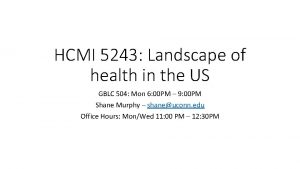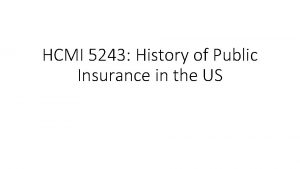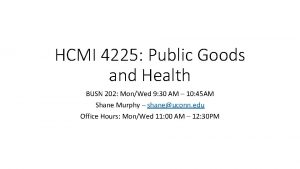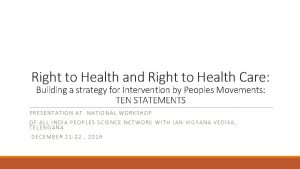HCMI 5243 The Right to Health and to



















































- Slides: 51

HCMI 5243: The Right to Health and to Health Care Shane Murphy – shane@uconn. edu

Arnold Kling’s Three Languages of Politics • Progressives: The Oppressed vs. Oppression • Conservatives: Civilization vs. Barbarism • Libertarian: Freedom vs. Coercion I might add the academics/beurocrats view: • The Expert vs. ignorance

Discussion Questions: • What is a right? What is a human right? • Is health care a human right? • Should the government ensure provision of basic health needs to the entire population? • Should the government ensure provision of premium health care to the entire population?

Rights in moral philosophy: Utilitarianism • Associated with founders of economics (Jeremy Bentham) • Policies should maximize net social utility • Aggregate welfare • Effective altruism (Singer) • Disease Control Priorities Project

Rights in moral philosophy: John Rawls’ Theory of Justice • Veil of ignorance • Under such a veil, what principles of justice would people choose for society • Maximin • Means rather than ends approach

Rights in moral philosophy: Communitarianism • Reaction to Rawls by Michael Sandel, Charles Taylor and Michael Walzer • Opposes universalist point of view • Distinct societies create distinct “spheres of justice” • Each society creates fundamental principles which are valued • Single community view called “Cosmopolitanism” (related to globalism or internationalism)

Rights in moral philosophy: Cosmopolitanism • Single community alternative to Communitarianism • Related to globalism or internationalism • Associated with Kant, Derrida, and Appiah • Moral universalism and belief of crimes against humanity

Rights in moral philosophy: Libertarian • Personal freedom • Individual choice and limited state influence • Anarchy, State, and Utopia (Nozick) • Endorse negative rights but not positive rights

Rights in moral philosophy: Capabilities approach • Focus on what individuals are able to do (Sen, Nussbaum) • Emphasizes functional capabilities, "substantive freedoms“ • the ability to live to old age • engage in economic transactions • participate in political activities

Rights in moral philosophy: Older views • Daoism • Focus on personal morality over community • Confucianism • Mutual obligation • Aristotelian ethics • Cardinal virtues and human flourishing – limited place for “rights” • Abrahamic traditions • Moses’ laws, Isaiah’s covenant, Jesus’ Beatitudes, Muhammad’s Al-Israa, Augustine’s City of God • Medieval philosophers • Influenced by Aristotle: Avicenna, Averroes, Maimonides, Aquinas,

Rights and Human Rights 1948 Universal Declaration of Human Rights • The preamble sets out the historical and social causes that led to the necessity of drafting the Declaration. • Articles 1– 2 established the basic concepts of dignity, liberty, equality, and brotherhood. • Articles 3– 5 established other individual rights, such as the right to life and the prohibition of slavery and torture. • Articles 6– 11 refer to the fundamental legality of human rights with specific remedies cited for their defence when violated. • Articles 12– 17 established the rights of the individual towards the community (including such things as freedom of movement). • Articles 18– 21 sanctioned the so-called "constitutional liberties", and with spiritual, public, and political freedoms, such as freedom of thought, opinion, religion and conscience, word, and peaceful association of the individual. • Articles 22– 27 sanctioned an individual's economic, social and cultural rights, including healthcare. Article 25 states: "Everyone has the right to a standard of living adequate for the health and well-being of himself and of his family, including food, clothing, housing and medical care and necessary social services. " It also makes additional accommodations for security in case of physical debilitation or disability, and makes special mention of care given to those in motherhood or childhood. • Articles 28– 30 established the general ways of using these rights, the areas in which these rights of the individual can not be applied, and that they can not be overcome against the individual.

Positive and Negative Rights • Negative Rights (first generation) are things which cannot be done to a person • Civil and political rights (including speech, religion, unlawful imprisonment) • Positive rights (second generation) are things which must be provided to a person • Include police protection, legal council, economic, social and cultural rights

Legal and natural rights • Natural rights are “universal” and “inalienable” (Locke, Paine, Hobbes) • Legal rights can be modified or repealed

Discussion Questions: • What is a right? What is a human right? • Is health care a human right? • Should the government ensure provision of basic health needs to the entire population? • Should the government ensure provision of premium health care to the entire population?

Federal Laws

US State Constitutions • As of April 2014, 15 state constitutions specifically mention health and health care—either in the form of a programmatic statement, public concern, individual right, or government duty.

Civil War pensions • Competitive, patronage oriented political parties • Republican coalition was complex and cut across class and region civil war pensions funded by precisely targeted tariffs could further electoral goals of the party • Administered by the US Bureau of Pensions (merged into the VA in 1930) • Pensions were advocated by the Grand Army of the Republic, a social group for veterans • GAR became an important political group • Disabled and elderly Veterans and their dependents were more generously aided than in fledgling welfare states of the day

Civil War pensions

Extending benefits beyond veterans • Proposals to extend Civil War benefits used the language of "army of labor" to generalize from the Union Army • Proposals had some limited support from trade unions • Early 1900 s proposals for old-age pensions, health and unemployment insurance, and labor regulations were rebuffed by the state • Popular support for these early programs floundered due to negative reactions to being seen as unfounded charity • Future programs would deal with this by becoming contributory • Failures at the federal level led to state level attempts had limited long-term success, but did develop ideas and expertise that would later be incorporated into the New Deal. Wisconsin - social insurance rather than tax financed welfare

Maternalist movement • However, maternalist welfare state did begin to form • In the early 1900 s, women's organizations grew in strength, pushing for women's rights as well as increased social protection for women • Both of these issues were cross-cutting, middle class women were aware of the possibility of destitution • Maternalist social organization was advocated especially by groups such as: • National Child Labor Committee, National Consumers League, the General Federation of Women's Clubs, the National Congress of Mothers, and the Daughters of the American Revolution.

Comparing maternalist and fraternal social organization • Male dominated social groups cut across class and region • But middle class female dominated groups formed with religious, charitable, and welfare purposes • Task of shaping public opinion was key both in influencing legislatures to act and influencing courts to accept • This was in contrast with courts striking down laws intended to shield unions, regulate working conditions, and regulate the market

Children’s Bureau (1912) • The Children's Bureau was a key federal program that resulted from this effort • Key leaders were Lillian Ward (Nurse, worked at juvinele wards, mental health advocate, co-founder of NAACP), Jane Addams (First US femal Peace Prize winner, cofounder of ACLU, city-level activist, Hull settlement house), Florence Kelley (labor advocate, cofounder NAACP, congressional advocate), and Julia Lothrop (social worker training, supported AALL push for greater public health insurance, Juvenile courts, first head of the Children's Bureau)

Key federal programs • Children's Bureau: • Birth registration Infant health campaigns commissioned studies Advocated for child labor protection - Keating Owen Act (1917 -1918) Sheppard-Towner Act (1921 -1929) New Deal • Sheppard-Towner Act • Midwife training programs, licensing, and enforcement Parent education through traveling health demonstrations, health centers, home visits, correspondence courses, and classes Establishment of standards and licensing procedures for maternity homes Data collection on maternal and infant mortality • Lacked elite support: Keating Owen Act (1917 -1918) - Killed by the Supreme Court Sheppard-Towner Act (1921 -1929) - Sunsetted/failed to be renewed

Otto van Bismarck • Minister President of Prussia from 1862 -1890 • Oversaw Prussian Military victories from 1863 -1871 • Oversaw Prussian led unified Germany in 1871 • Then appointed Imperial Chancellor, serving from 18711890 • “First” social insurance scheme in 1881, 1883, & 1884 • Employer based: employers paying 2/3, employees 1/3 • Responding to rising social movements and combat socialism

Why Germany? • Germany saw greatest level of industrial growth in late 1800 s • German political philosophers (such as Fichte, Wagner, and Schaeffle) were less libertarian than Anglo counterparts (Smith, Mill, Franklin) • Note that in many ways, Marx was more pro-state than French Socialists • Well developed labor movement • 1848 revolutions • Goals: Democracy (anti-monarchy and pro working class), social justice, and, in the case of Germany, unification • Bismark worked with German Socialists from 1848 revolutions such as Lasalle

Initial forms • First: Accident and sickness insurance • Sickness in 1883, accident in 1884 • Base on no-fault principle, industrial accidents a fact of life • Later: Old age and invalidity • Even later: • Insurance for survivors of industrial accidents (widows and orphans) • Maternity insurance (First program created in 1911 in Italy) • Four Social Risks: injury, sickness, old age, and unemployment

Spread of accident insurance • Social insurance programs were initially slow to spread, with only Germany, Austria, and Hungary having programs by 1894 • But by 1904, most of Western, Central, and Northern Europe had programs • United States was late, creating a program for federal employees only in 1908 • Two years after the creation of a program in Mexico (then called Nuevo Leon) • Canadian provinces largely created programs between 1908 -1910 • Sickness insurance did not spread as quickly

Sick, old-age, and unemployment insurance • Spread was slower • Initial programs were largely subsidy based and voluntary • Unemployment insurance programs were more popular at local levels

Federal and State programs in the US • First state social insurance law was in Maryland in 1902 • • • Accident insurance For workers in mines, quarries, and steam and electric railroads Granted $1, 000 in case of fatal accident Based on equal employee and employer contributions Declared unconstitutional in 1904 • Grounds that it deprived both parties right of trial by jury

Other early programs • Voluntary, equal contribution accident programs were set up in Massachusetts and Illinois in 1905 and 1908, but these were not popular among workers and unions • Connecticut state legislature investigation in 1907 found such programs would be good, but could not find a solution out of fear of interstate competition • However, Theodore Roosevelt succeeded in passing an accident insurance bill for US employees in 1908 • He had supported a similar bill when he was governor of NY in the 1890 s

State programs • Early programs by Maryland (1904), Montana (1910) and New York (1910) were later declared unconstitutional • Other 1910 programs by Massachusetts, Maryland, and New York were voluntary and failed • Starting in 1911, States began enacting effective programs

Phossy Jaw and the AALL • American Association for Labor Legislation sough federal regulation of yellow phosphorus used in match manufacturing • Substitutes existed, the substance was banned in Europe, and it led to a painful, debilitating and sometimes deadly condition • Phosphorus necrosis • AALLs first movement was successful, and regulation began in 1912

Characteristics of initial state programs • Limited scope • Limited forms of industries • Iron and steel building erection, elevator operation, work on scaffolding, electricians, work with/near explosives, railworkers, construction of tunnels and subways, and compressed air work. • Dangerous operation with little interstate competition • Constitutional legality based on police power of state • Elective programs included changes to liability law • Non-electing companies no longer as able to waive liabilities • Electing employees reduced in ability to extract unlimited damages • But such progras generally were unsuccessful

Nudges • In most states, most employers did not elect to join scheme • Laborers were not in a strong position and were not generally able to take advantage of increased legal rights • Voluntary program in New Jersey was exception • In NJ, employers were assumed to have elected to join scheme unless they made a specific statement not to join • Many employers were uninterested or uninformed and joined by default • Voluntary program in Illinois was another exception • In both NJ and Illinois, insurance rates were lower so compensation was cheaper than liability

1935 Social Security Act and the Welfare State in the US • Federal Old Age, Survivors, Disability and Hospital Insurance Program • Originally entitled the Federal Old Age Benefits (I) program • Program now also encompasses Medicare and is funded through FICA • Federal-state unemployment compensation program • FUTA (1954) • 9 other programs including aid to states for programs for the blind (X), needy dependent children (IV) • Avoided using the word “insurance” to provide some protection from conservative SC justices – but programs were called social insurance after SC ruling in support in 1939 • American Medical Association opposed early efforts for state or national health insurance

Health Insurance programs in the Social Security Act • Four key programs • • Maternal and Child Health Crippled Children Services Vocational rehabilitation Public Health • Created as grants to states for state run programs • Initial plans included national health insurance, which AMA opposed and FDR thought was politically too risky, eventual AMA support of Act was reluctant

New Deal • First New Deal included banking reform, the National Recovery Administration, and the Civil Works Administration • Second New Deal included labor union protections, establishment of the Works Progress Administration, the creation of the US Housing Authority, the Fair Labor and Standards Act of 1938, and the Social Security Act • FDR (a New York Democrat) vs the conservative coalition of Republicans and Southern Democrats • Harry F. Byrd Sr was a noted leader of the conservative coalition • Opposed Federal control over standards for old age assistance and other programs

Rise of Fascism, American Fascism, and the New Deal • Mussolini, not Hitler, was the superstar of Fascist politics in the early 1930 s • • Fritz Julius Kuhn’s German-American Bund, founded in 1936 William Dudley Pelley’s Silver Legion, founded in 1933 Business Plot of 1933 William Joseph Simmons’s 2 nd KKK, founded in 1915 • William Shepard and Virgil Effinger’s Black Legion, founded in 1920 s, Effinger took control in 1931 • National Industrial Recovery Act of 1933 - authorized the President to regulate industry for fair wages and prices • Supported by Huey Long and Father Charles Coughlin • Recognized as being modelled on Italian cooperative state • However, Italian statism, liberals argued, was in the service of the state • The NRA sought to protect the interests of the people • German and Italian Fascism came to be identified with business interests • New Deal philosophy more closely resembled the British Labor Party or Social Corporatism/Social Democracy (1930 s Norway and Sweden) • Division grew and by 1939, the New Deal was called the Jew Deal by Kuhn

World Wars • World War I (1914 -1918) and World War II (1939 -1945) • WWI: Allied Powers (France, Britain, Russia, Serbia, Belgium, Japan, Italy, US, Romania, Portugal, US, China, and others) vs Central Powers (Germany, Austria-Hungary, Ottoman Empire (Turkey), Bulgaria) • WWII: Allies (Russia [1941], US [1941], UK, China) vs Axis (Germany, Japan, Italy) • In 1919, as a part of the Treaty of Versailles, the International Labor Organization was created (now a part of the UN) • In 1927, the International Social Security Association was established affiliated with the ILO • In 1945, the UN was established

Communist programs • Leninist social insurance programs based on two 1912 principles • Cost solely responsibility of employers • Administration by employees • Program evolved greatly in 1930 s • Centralized in 1931, expanded to include health care in 1936 • Adopted by China in 1930 s and other socialist countries after WWII

Spread of the German Model • Old age and sickness insurance in the German model spread through non-Communist states more quickly after 1919 • US adopted old-age and unemployment insurance in 1935

1941, Roosevelt, and WWII • Four Freedoms - https: //www. youtube. com/watch? v=qr. NDwyj 4 u 1 w – Jan 6 • Freedom of speech, Freedom of worship, Freedom from want, Freedom from fear • The third is freedom from want—which, translated into world terms, means economic understandings which will secure to every nation a healthy peacetime life for its inhabitants— everywhere in the world. • Atlantic Charter - https: //www. youtube. com/watch? v=-ms. KSTzm. Qxk – Aug 14 • Set ideological goals of Anglo-American alliance • WWII was not just to be a military war against Germany and the axis, but also an ideological war against Naziism and Fascism • 5. The desire to bring about the fullest collaborations between all nations in the economic field with the object of scoring, for all, improved labor standards, economic advancement and social security. • Pearl Harbor bombed – Dec 7

1942: Stabilization Act • During WWII, increased government spending was leading to inflation • Increased demand for war-time goods and increased demand for workers due to increased military spending led to labor shortages • Bill meant to combat inflation and labor shortages • Limit employer’s ability to raise wages • Employer response was to increase benefits • Health benefits became part of employment packages

Social Security development during WWII • 1941 UK: Beveridge Plan • Led to the creation of social programs in the UK forming the Welfare State • Family Allowances Act 1945, National Insurance (Industrial Injuries) Act 1946, National Insurance Act 1946, National Health Service Act 1946, Pensions (Increase) Act 1947, Landlord and Tenant (Rent Control) Act 1949, National Insurance (Industrial Injuries) Act 1948, National Insurance Act 1949 • 1943 US: Wagner-Murray-Dingell Bill • Failed law for national medical and hospitalization coverage • • 1943 Canada: Marsh Plan 1944 India: India Beveridge Plan 1945 China, etc By the 1950 s, most industrial capitalist countries had comprehensive systems for all of the four social risks

UN Declaration of Human Rights • Proclaimed by the United Nations General Assembly in Paris on 10 December 1948 • https: //www. youtube. com/watch? v=Lp-3 CQ 6 ZD 4 k • Article 25. • (1) Everyone has the right to a standard of living adequate for the health and well-being of himself and of his family, including food, clothing, housing and medical care and necessary social services, and the right to security in the event of unemployment, sickness, disability, widowhood, old age or other lack of livelihood in circumstances beyond his control. • (2) Motherhood and childhood are entitled to special care and assistance. All children, whether born in or out of wedlock, shall enjoy the same social protection.

Federal Laws

US State Constitutions • As of April 2014, 15 state constitutions specifically mention health and health care—either in the form of a programmatic statement, public concern, individual right, or government duty.

LBJ and the Great Society • Civil Rights Act of 1964 outlawed discrimination based on race, color, religion, sex, or national origin • Voting Rights Act of 1965 • Section 5 largely struck down by Shelby County v. Holder (2013) • War on Poverty • 1964 creation of the Office of Economic Opportunity • Job corps and work training programs • Head Start • 1965 Elementary and Secondary Education Act • Housing and Urban Development Act of 1965 • National Endowment for the Humanities and the National Endowment for the Arts • 1965 National Foundation on the Arts and Humanities Act • Environmental legislation • Pro-immigration legislation • https: //youtu. be/n. XVAOcs 5 o. VA? t=24

1965: Social Security Amendments of 1965 (Medicare and Medicaid) • Major issue in 1962 Kennedy Campaign (Kennedy was assassinated in 1963) • Johnson strongly supported legislation • Initial proposal failed in 1964 • Supported by the AFL-CIO, both parties

1970: Title X • Provides federal support for comprehensive family planning and related preventive health services • prioritize the needs of low-income families or uninsured people (including those who are not eligible for Medicaid) • These services are provided to low-income and uninsured individuals at reduced or no cost. • Created in 1970 • FDA approved the Pill in 1960 • Planned Parenthood formed in 1916, changed name to Planned Parenthood in 1942, large advocate for Title X

Readings: • Health care as a public good *Karsten, Siegfried G. "Health care: private good vs. public good. " American Journal of Economics and Sociology 54, no. 2 (1995): 129 -144. *Galea, Sandro. “Public health as a public good. ” Boston University School of Public Health, January 10, 2016, https: //www. bu. edu/sph/2016/01/10/public-health-as-a-public-good/ • Is health care a right? Is health insurance a right? *Gawande, Atul. “Is health care a right? ” New Yorker, October 2, 2017 *Section I (pages 5 -10) of Ruger, Jennifer Prah. “Toward a theory of a right to health: capability and incompletely theorized agreements. ” Yale Journal of Law & the Humanities 18, no. 2 (2006): 3. *Hamel, Mary Beth, Jennifer Prah Ruger, Theodore W. Ruger, and George J. Annas. “The elusive right to health care under US Law. ” N Engl J Med 372, no. 26 (2015): 2558 -63. *Ruger, Jennifer P. “The moral foundations of health insurance. ” Journal of the Association of Physicians 100, no. 1 (2007): 53 -57.
 Right product right place right time right price
Right product right place right time right price Right time right place right quantity right quality
Right time right place right quantity right quality Cse 5243
Cse 5243 5243-2126
5243-2126 The right man on the right place at the right time
The right man on the right place at the right time Left left right right go turn around go go go
Left left right right go turn around go go go Put your left foot in
Put your left foot in Left left right right go go go
Left left right right go go go Health and social component 3
Health and social component 3 Hát kết hợp bộ gõ cơ thể
Hát kết hợp bộ gõ cơ thể Ng-html
Ng-html Bổ thể
Bổ thể Tỉ lệ cơ thể trẻ em
Tỉ lệ cơ thể trẻ em Chó sói
Chó sói Glasgow thang điểm
Glasgow thang điểm Bài hát chúa yêu trần thế alleluia
Bài hát chúa yêu trần thế alleluia Các môn thể thao bắt đầu bằng tiếng đua
Các môn thể thao bắt đầu bằng tiếng đua Thế nào là hệ số cao nhất
Thế nào là hệ số cao nhất Các châu lục và đại dương trên thế giới
Các châu lục và đại dương trên thế giới Công thức tính thế năng
Công thức tính thế năng Trời xanh đây là của chúng ta thể thơ
Trời xanh đây là của chúng ta thể thơ Mật thư anh em như thể tay chân
Mật thư anh em như thể tay chân Làm thế nào để 102-1=99
Làm thế nào để 102-1=99 độ dài liên kết
độ dài liên kết Các châu lục và đại dương trên thế giới
Các châu lục và đại dương trên thế giới Thơ thất ngôn tứ tuyệt đường luật
Thơ thất ngôn tứ tuyệt đường luật Quá trình desamine hóa có thể tạo ra
Quá trình desamine hóa có thể tạo ra Một số thể thơ truyền thống
Một số thể thơ truyền thống Cái miệng bé xinh thế chỉ nói điều hay thôi
Cái miệng bé xinh thế chỉ nói điều hay thôi Vẽ hình chiếu vuông góc của vật thể sau
Vẽ hình chiếu vuông góc của vật thể sau Thế nào là sự mỏi cơ
Thế nào là sự mỏi cơ đặc điểm cơ thể của người tối cổ
đặc điểm cơ thể của người tối cổ Thứ tự các dấu thăng giáng ở hóa biểu
Thứ tự các dấu thăng giáng ở hóa biểu Vẽ hình chiếu đứng bằng cạnh của vật thể
Vẽ hình chiếu đứng bằng cạnh của vật thể Tia chieu sa te
Tia chieu sa te Thẻ vin
Thẻ vin đại từ thay thế
đại từ thay thế điện thế nghỉ
điện thế nghỉ Tư thế ngồi viết
Tư thế ngồi viết Diễn thế sinh thái là
Diễn thế sinh thái là Các loại đột biến cấu trúc nhiễm sắc thể
Các loại đột biến cấu trúc nhiễm sắc thể Số nguyên tố là gì
Số nguyên tố là gì Tư thế ngồi viết
Tư thế ngồi viết Lời thề hippocrates
Lời thề hippocrates Thiếu nhi thế giới liên hoan
Thiếu nhi thế giới liên hoan ưu thế lai là gì
ưu thế lai là gì Khi nào hổ mẹ dạy hổ con săn mồi
Khi nào hổ mẹ dạy hổ con săn mồi Sự nuôi và dạy con của hươu
Sự nuôi và dạy con của hươu Hệ hô hấp
Hệ hô hấp Từ ngữ thể hiện lòng nhân hậu
Từ ngữ thể hiện lòng nhân hậu Thế nào là mạng điện lắp đặt kiểu nổi
Thế nào là mạng điện lắp đặt kiểu nổi Aaaq right to health
Aaaq right to health








































































